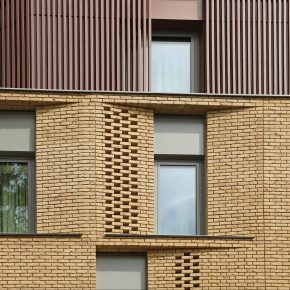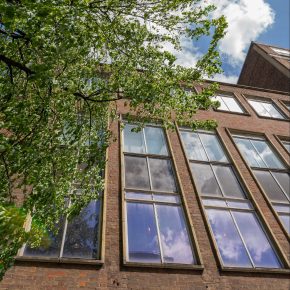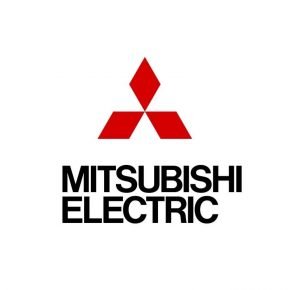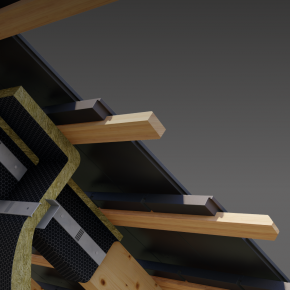
Smoke Ventilation Systems – Natural Vs Mechanical
One of the most important aspects of any property, building, or premises is its fire safety. Smoke ventilation systems are an essential part of this and can literally mean the difference between life and death. When it comes to implementing an effective system for your property, you will need to choose between mechanical smoke ventilation and natural smoke ventilation. Here we provide some helpful information, guidance, and advice about natural and mechanical smoke ventilation systems to help you make an informed decision about your building ventilation.

What is Natural Smoke Ventilation?
A natural ventilation system exploits the natural properties and innate characteristics of smoke, such as buoyancy, to help effectively remove it from buildings. This often involves AOV systems (Automatic Opening Vents), and dampers strategically placed at different levels within the property. They can be triggered to open by smoke, fire, or emergency personnel. When open, smoke and heat can escape through the vents at high level, fresh air is drawn in as this happens leaving vital exit routes clear and safe for people to evacuate.
What is Mechanical Smoke Ventilation?
This type of system uses dampers, ductwork, vents, and other electrical elements to direct the smoke out of the building. The smoke is mechanically removed with fans which create pressure differentials instead of hot air buoyancy.
What Are the Advantages and Disadvantages of Both?
Pros of Natural Smoke Ventilation:
- Natural ventilation is overall, a simpler system, requiring significantly fewer components to implement.
- Whilst not recommended, due to the reduced equipment lifespan, the systems can be used for comfort ventilation, not just for smoke ventilation, helping to improve indoor air quality, remove stale air and odours, and bring in fresh, clean air.
- Natural ventilation is very cost-effective with lower upfront costs than mechanical systems as well as lower maintenance costs.
Cons of Natural Smoke Ventilation:
- The effectiveness of natural smoke ventilation systems can be impacted by things such as the weather. This means that you have limited control, and it might not function as well during periods of low winds, humidity, or high heat.
- Natural ventilation requires larger smoke shaft and structural openings over all as the airflow is not forced and relies on natural convection.
Pros of Mechanical Smoke Ventilation:
- These systems are very consistent and can operate effectively regardless of weather conditions to provide steady, regular, and even temperature control and airflow.
- Mechanical systems allow for greater control over the internal environment and can provide specific levels airflow on demand.
Cons of Mechanical Smoke Ventilation:
- Because the number of powered components is higher, they require more energy.
- They tend to have much higher upfront costs as well as more regular and costly maintenance.
- Detailed computer simulations (CFDs) are required to prove their effectiveness. This is an expensive process costing many thousands of pounds per simulation. The same simulations are not required for natural ventilation of smoke.
Which One is Better, Natural or Mechanical Smoke Ventilation?
Both types of smoke ventilation have their advantages, but the appropriate choice will be the type of system that is best suited to the individual building, taking into account things like its height, travel distances, and space. It is always a good idea to consult with a professional who specialises in smoke ventilation as they will be able to ensure that you choose the system that is most suitable.
Latest news

17th May 2024
Vandersanden bricks ensure student accommodation blends with Oxford heritage
An eco-friendly development targeting the Passivhaus Low Energy Building Standard, Castle Hill House provides undergraduate accommodation for students of St Peter’s College, University of Oxford – Vandersanden bricks feature there.
Posted in Articles, Bricks & Blocks, Building Industry News, Building Products & Structures, Case Studies, Facades, Restoration & Refurbishment, Retrofit & Renovation, Sustainability & Energy Efficiency, Walls
16th May 2024
ASWS renovates steel window frontage to Edgware Road events venue
Renovating the ageing steel windows within the frontage to a very popular events venue on the Edgware Road posed particular challenges for Associated Steel Window Services (ASWS).
Posted in Articles, Building Associations & Institutes, Building Industry News, Building Products & Structures, Building Services, Building Systems, Case Studies, Glass, Glazing, Lighting, Restoration & Refurbishment, Retrofit & Renovation, Steel and Structural Frames, Windows
16th May 2024
Mitsubishi Electric opens state-of-the-art heat pump training centre in Livingston
Mitsubishi Electric has opened a new training centre at its factory complex in Livingston, Scotland, in answer to the UK’s growing demand for heat pumps.
Posted in Articles, Building Industry Events, Building Industry News, Building Products & Structures, Building Services, Facility Management & Building Services, Heating Systems, Controls and Management, Heating, Ventilation and Air Conditioning - HVAC, Information Technology, Innovations & New Products, Pipes & Fittings, Plumbing, Posts, Retrofit & Renovation, Sustainability & Energy Efficiency, Training
15th May 2024
ROCKWOOL® announces launch of new Fire Barrier EN
To help designers and specifiers improve building fire safety, stone wool insulation manufacturer ROCKWOOL® has launched a new fire barrier product that is tested in accordance with the latest BS EN standards.
Posted in Articles, Building Industry News, Building Products & Structures, Building Regulations & Accreditations, Building Systems, Concrete, Cement, Admixtures, Drainage, Guttering, Soffits & Fascias, Health & Safety, Heating Systems, Controls and Management, Heating, Ventilation and Air Conditioning - HVAC, Innovations & New Products, Insulation, Pipes, Pipes & Fittings, Plumbing, Retrofit & Renovation, Timber Buildings and Timber Products, Walls
 Sign up:
Sign up: